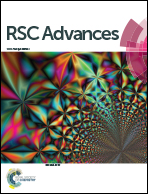Supercritical CO2 synthesized TiO2 nanowires covalently linked with core–shell CdS–ZnS quantum dots: enhanced photocatalysis and stability
Abstract
Semiconductor quantum dots (QDs) sensitized onto nano TiO2 as heterogeneous photocatalysts have drawn considerable interest over the past few years. However, stability of the QDs attached to TiO2 and consistent photocatalysis are still major challenges of this approach. We describe herein, a facile process to fabricate nanocomposites from porous TiO2 nanowires and bare CdS and core–shell CdS–ZnS QDs, where the QD particles are linked covalently to the titania surface through a bifunctional organic linker, mercapto propionic acid (MPA). A thin layer of ZnS was grown on 6 nm CdS QDs to restrain the photocorrosion and passivate the trap states, enhancing the photoluminescence and quantum yield. The bifunctional linking molecule, MPA, was found to effectively disperse and stabilize the QD nanoparticles. The photocatalytic activities of the prepared catalysts were evaluated under ultraviolet and visible light solar irradiation for the photodegradation of methylene blue (MB), an organic dye. The decomposition rate of MB was enhanced as follows: CdSZnS–MPA–TiO2 > CdS–MPA–TiO2 > CdSZnS–TiO2 > CdS–TiO2 > TiO2 > P25. A maximum photodegradation efficiency of MB dye (∼88%) was obtained by core–shell CdS–ZnS QDs linked with nano TiO2. After 3 cycling tests of degradation, the loss of photoactivity was significantly minimized (from 68% to 10%) by CdSZnS–MPA–TiO2 compared to CdSZnS–TiO2 (by direct deposition).


 Please wait while we load your content...
Please wait while we load your content...